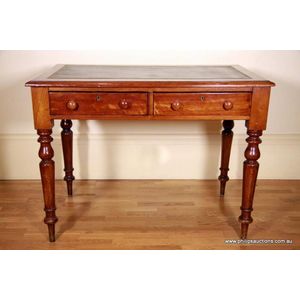Victorian Cedar Writing Table
You must be a subscriber, and be logged in to view price and dealer details.
Subscribe Now to view actual auction price for this item
When you subscribe, you have the option of setting the currency in which to display prices to $Au, $US, $NZ or Stg.
- Turning - Any part of a piece of furniture that has been turned and shaped with chisels on a lathe. Turned sections include legs, columns, feet, finials, pedestals, stretchers, spindles etc. There have been many varieties and fashions over the centuries: baluster, melon, barley-sugar, bobbin, cotton-reel, rope-twist, and so on. Split turning implies a turned section that has been cut in half lengthwise and applied to a cabinet front as a false decorative support.
- Turned Legs - are legs which have been turned on a lathe. In use from the 16th century, turned legs on tables, chairs and cabinets became more frequent until, by the 1830s, the Georgian square or tapered leg was rarely found except in country pieces.
- Frieze - An architectural term denoting the flat, shaped or convex horizontal surface of furniture, between the architrave and the cornice, usually found on a cabinet or bookcase, or on desks and tables where it may include drawers, the area between the top and the legs. In ceramics, the term refers to the banding, of usually a repeating pattern, on the rims of plates and vases.
- Victorian Period - The Victorian period of furniture and decorative arts design covers the reign of Queen Victoria from 1837 to 1901. There was not one dominant style of furniture in the Victorian period. Designers used and modified many historical styles such as Gothic, Tudor, Elizabethan, English Rococo, Neoclassical and others, although use of some styles, such as English Rococo and Gothic tended to dominate the furniture manufacture of the period.
The Victorian period was preceded by the Regency and William IV periods, and followed by the Edwardian period, named for Edward VII (1841 ? 1910) who was King of the United Kingdom and the British Dominions and Emperor of India for the brief period from 1901 until his death in 1910.
This item has been included into following indexes:
-
desks, style or type
- table style 197
- writing table 128
Visually similar items

A Victorian mahogany two drawer hall table mid 19th century. The table has turned legs with two half size drawers and turned knob handles. Height 73.5 cm. Width 104 cm. Depth 45 cm

A small Victorian leather topped desk. 19th century, having a tooled green leather top, a bullnose edge and two pine lined frieze drawers with simple timber handles, supported on turned and baluster legs. Height 76 cm. Width 103 cm. Depth 61 cm

A small Victorian cedar leather topped desk. second half 19th century, the desk with an olive green tooled leather top above two drawers each with a pair of turned timber handles, raised upon slender baluster and turned legs. Height 78 cm. Width 105 cm. De

Regency gallery top wash stand, with 2 drawers, 107 cm wide, 50 cm deep, 83 cm high
